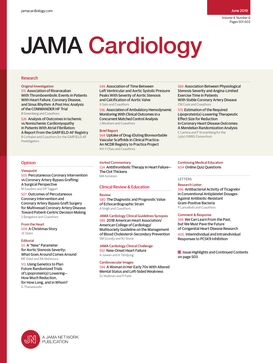芬芬烯酮治疗心力衰竭并改善射血分数:finhearts - hf随机临床试验。
IF 14.1
1区 医学
Q1 CARDIAC & CARDIOVASCULAR SYSTEMS
引用次数: 0
摘要
慢性心力衰竭(HF)和左心室射血分数(LVEF)低于40%的患者,即使LVEF改善到40%或更高(HFimpEF),仍可能面临剩余风险。目的评估HFimpEF患者的临床特征、风险和对芬烯酮的治疗反应。设计、环境和参与者:在2020年9月14日至2023年1月10日期间,共有6001例HE、LVEF为40%或更高、纽约心脏协会II至IV级症状和利钠肽水平升高的患者入组。既往LVEF病史低于40%的患者被纳入研究。数据分析时间为2024年9月1日至12月10日。干预:参与者接受芬尼酮(滴定至20毫克或40毫克)或安慰剂。主要结局和测量主要终点是心血管(CV)死亡和总(首次和复发)心衰恶化事件的组合。结果6001名参与者(平均[SD]年龄72[9.7]岁;3269例男性[55%]),273例(5%)既往LVEF小于40%。在既往LVEF小于40%的患者中,记录的既往LVEF中位数为35% [IQR, 30%-37%],改善中位数为12% [IQR, 8%-17%]。在中位随访2.6年期间,LVEF史小于40%的患者CV死亡和HF事件恶化的主要结局发生率高于LVEF持续为40%或更高的患者(21.4 / 100患者年vs 16.0 / 100患者年)。经临床相关协变量调整后;但两组间的发病率比(RR)无统计学差异(绝对RR, 1.13;95% ci, 0.85-1.49, p = 0.39)。细芬烯酮对主要结局的治疗效果在LVEF史小于40%和LVEF史始终为40%或更高的患者中是一致的(相互作用P = 0.36)。由于基线风险较高,HFimpEF患者的绝对风险降低幅度更大(9.2 vs 2.5 / 100患者年)。芬尼酮治疗HFimpEF患者倾向于出现更多的低血压,但除此之外,芬尼酮在既往LVEF低于40%的患者和未发生LVEF的患者中的安全性相似。结论和相关性在这项预先指定的随机临床试验分析中,hfvef患者仍然处于CV事件的高风险中,这强调了尽管LVEF改善,但仍需要持续管理。芬尼酮在保留EF的HF患者中观察到的治疗效果与HFimpEF患者一致。临床试验注册号:NCT04435626。本文章由计算机程序翻译,如有差异,请以英文原文为准。
Finerenone in Heart Failure With Improved Ejection Fraction: The FINEARTS-HF Randomized Clinical Trial.
Importance
Patients with chronic heart failure (HF) and left ventricular ejection fraction (LVEF) less than 40% who experience LVEF improvement to 40% or higher (HFimpEF) may still face residual risks.
Objective
To assess the clinical profiles, risk, and treatment response to finerenone in participants with HFimpEF.
Design, Setting, and Participants
A total of 6001 patients with HE, LVEF of 40% or higher, New York Heart Association class II to IV symptoms, and elevated natriuretic peptide levels, were enrolled between September 14, 2020, and January 10, 2023. Patients with a prior history of LVEF less than 40% were included. Data analysis was conducted between September 1 to December 10, 2024.
Intervention
Participants received finerenone (titrated to 20 mg or 40 mg) or placebo.
Main Outcomes and Measures
The primary end point was the composite of cardiovascular (CV) death and total (first and recurrent) worsening HF events.
Results
Of the 6001 participants (mean [SD] age, 72 [9.7], years; 3269 male [55%]), 273 (5%) had a prior LVEF less than 40%. Among those with a prior LVEF of less than 40%, the median recorded prior LVEF was 35% [IQR, 30%-37%], with a median improvement of 12% [IQR, 8%-17%]. Over a median follow-up of 2.6 years, those with a history of LVEF of less than 40% experienced higher rates of the primary outcome of a composite of CV death and worsening of HF events (21.4 per 100 patient-years vs 16.0 per 100 patient-years) than did those whose LVEF was consistently 40% or higher. After adjustment for clinically relevant covariates; however, this rate ratio (RR) was not statistically different (absolute RR, 1.13; 95% CI, 0.85-1.49, P = .39). The treatment effect of finerenone on the primary outcome was consistent among those with a history of LVEF less than 40% and those with LVEF that was consistently 40% or higher (P for interaction = .36). Owing to higher baseline risk, the absolute risk reduction was greater among those with HFimpEF (9.2 vs 2.5 per 100 patient-years). Patients with HFimpEF tended to develop more hypotension with finerenone treatment, but otherwise, the safety profile of finerenone was similar in patients with and without previous LVEF less than 40%.
Conclusions and Relevance
In this prespecified analysis of a randomized clinical trial, patients with HFimpEF remained at high risk of CV events, underscoring the need for continued management despite LVEF improvement. The treatment benefits of finerenone observed among the overall population of patients with HF with preserved EF were consistent among patients with HFimpEF.
Trial Registration
ClinicalTrials.gov Identifier: NCT04435626.
求助全文
通过发布文献求助,成功后即可免费获取论文全文。
去求助
来源期刊

JAMA cardiology
Medicine-Cardiology and Cardiovascular Medicine
CiteScore
45.80
自引率
1.70%
发文量
264
期刊介绍:
JAMA Cardiology, an international peer-reviewed journal, serves as the premier publication for clinical investigators, clinicians, and trainees in cardiovascular medicine worldwide. As a member of the JAMA Network, it aligns with a consortium of peer-reviewed general medical and specialty publications.
Published online weekly, every Wednesday, and in 12 print/online issues annually, JAMA Cardiology attracts over 4.3 million annual article views and downloads. Research articles become freely accessible online 12 months post-publication without any author fees. Moreover, the online version is readily accessible to institutions in developing countries through the World Health Organization's HINARI program.
Positioned at the intersection of clinical investigation, actionable clinical science, and clinical practice, JAMA Cardiology prioritizes traditional and evolving cardiovascular medicine, alongside evidence-based health policy. It places particular emphasis on health equity, especially when grounded in original science, as a top editorial priority.
 求助内容:
求助内容: 应助结果提醒方式:
应助结果提醒方式:


